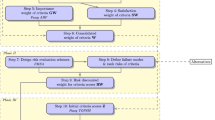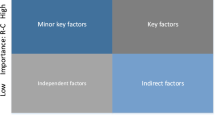Abstract
Risk analysis methods, the integration of which leads to more realistic and reliable solutions, are gaining increasing acceptance as decision support tools for the analyses and reduction of risks in engineering applications. This paper aims at presenting an integrated method that can identify and evaluate serious failures in achieving the desired project objectives due to the presence of risks/uncertainties in different execution stages. Since a dredging project’s effective efficiency evaluation is a vital element in the success of ports’ loading/unloading operations, the authors aim at developing a risk evaluation method to check why Shahid Rajaee Port dredging projects incur unintended damage. The FSA (formal safety assessment)-based approach integrates FST (fuzzy set theory), GOWPA (generalized ordered weighted proportional averaging), and DEMATEL (decision-making trial and evaluation laboratory) techniques and results of this case study show that the fuzzy DEMATEL method can be used to evaluate how direct/indirect relations and elements affect one another and promote the quality of the group relations/interrelations. Conclusions and suggestions regarding the need to lessen risks and improve safety measures have been provided in the final section.










Similar content being viewed by others
Change history
17 June 2020
The family name of the co-author of this article was misspelled. The correct name is Mohammad Ali Khaleghi.
References
Ahn BS (2006) The uncertain OWA aggregation with weighting functions having a constant level of orness. Int J Intell Syst 21:469–483
Al-Najjar B, Alsyouf I (2003) Selecting the most efficient maintenance approach using fuzzy multiple criteria decision making. Int J Prod Econ 84(1):85–100. https://doi.org/10.1016/S0925-5273(02)00380-8
Aven T, Erik Vinnem J (2005) On the use of risk acceptance criteria in the offshore oil and gas industry. Reliab Eng Syst Saf 90(1):15–24
Basahel A, Taylan O (2016) Usıng fuzzy Ahp and fuzzy Topsıs approaches for assessıng safety condıtıons at worksıtes in constructıon industry. Int J Saf Secur Eng 6:728–745
Bellman R, Zadeh LA (1970) Decision making in a fuzzy environment. Manag Sci 17(4):141–164
Buyukozkan G, Cifci G (2012) A novel hybrid MCDM approach based on fuzzy DEMATEL fuzzy ANP and fuzzy TOPSIS to evaluate green suppliers. Expert Syst Appl 39:3000–3011
Calvo T, Mesiar R, Yager RR (2004) Quantitative weights and aggregation. IEEE Trans Fuzzy Syst 12:62–69
Chang CP, Berdiev AN (2013) Natural Disasters, Political Risk and Insurance Market Development, Geneva Papers on Risk and Insurance, 38(1):406–448
Cheng A-C (2013) A fuzzy multiple criteria comparison of technology valuation methods for the new materials development. Technol Econ Dev Econ 19(3):397–408
Chiclana F, Herrera F, Herrera-Viedma E (2000) The ordered weighted geometric operator: properties and applications. In: Proceeding 8th International Conference on Information Processing and Management of Uncertainty in Knowledge-Based Systems, Madrid, Spain, pp. 985–991
Dalalah D, Hayajneh M, Batieha F (2011) A fuzzy multi-criteria decision making model for supplier selection. Expert Syst Appl 38(7):8384–8391
Efe B, Kurt M, Efe Ö (2017) An integrated intuitionistic fuzzy set and mathematical programming approach for an occupational health and safety policy. Gazi Univ J Sci 30:73–95
Elliot M, Hemingway KL (2002) Fishes in estuaries. Blackwell Publications, Oxford 626 pp
Emovon I, Norman R, Murphy A (2016) An integration of multi-criteria decision making techniques with a delay time model for determination of inspection intervals for marine machinery systems. Appl Ocean Res 59:65–82
Gabus A, Fontela E (1972) World problems an invitation to further thought within the framework of DEMATEL. Battelle Geneva Research Centre, Switzerland
Gabus A, Fontela E (1973) Perceptions of the world problematique: communication procedure, communicating with those bearing collective responsibility
Kahraman C, Ertay T, Buyukozkan G (2006) A fuzzy optimization model for QFD planning process using analytic network approach. Eur J Oper Res 171:390–411
Kim IJ, Krishna R, Suresh S (1993) Does default risk in coupons affccl the valuatim of corporate bonds? A contingent claims model, Financial Management 22:117–131
Kim DI, Yoo WS, Cho H, Kang KI (2014) A fuzzy AHP-based decision support model for quantifying failure risk of excavation work. KSCE J Civ Eng 18:1966–1976
Klir GJ, Yuon B (1995) Fuzzy sets and fuzzy logics: theory and applications. Prentice-Hall, New Jersey
Kontovas CA, Psaraftis HN (2006) Formal safety assessment: a critical review and ways to strengthen it and make it more transparent. NTUA-MT-06-102, School of Naval Architecture and Marine Engineering National Technical University of Athens Greece
Kontovas CA, Psaraftis HN (2009) Formal safety assessment: a critical review. Mar Technol 46(1):45–59
Lee JO, Yeo IC, Yang YS (2001) A trial application of FSA methodology to the hatchway watertight integrity of bulk carriers. Mar Struct 14:651–667
Lin (2009) A new two-stage hybrid approach of credit risk in banking industry. Expert Systems with Applications. https://doi.org/10.1016/j.eswa.2008.10.015
Lin C-Y, Lee AHI, Kang H-Y (2015) An integrated new product development framework—an application on green and low-carbon products. Int J Syst Sci 46(4):733–753
Liu H, Tsai Y (2012) A fuzzy risk assessment approach for occupational hazards in the construction industry. Saf Sci 50:41067–41078
Malik SK (2016) Generalized MCDM-based decision support system for personnel prioritization. In: Proceedings of international conference on ICT for sustainable development. Springer, Singapore, pp. 155–168
Mardani A, Jusoh A, Nor K, Khalifah Z, Zakwan N, Valipour A (2015) Multiple criteria decision-making techniques and their applications—a review of the literature from 2000 to 2014. Econ Res Ekon Istraž
Mentes A, Ozen E (2015) A hybrid risk analysis method for a yacht fuel system safety. Saf Sci 79:94–104
Mentes A, Akyildiz H, Yetkin M, Turkoglu N (2015) A FSA based fuzzy DEMATEL approach for risk assessment of cargo ships at coasts and open seas of Turkey. Saf Sci 79:1–10
Merigó JM (2010) Fuzzy decision making with immediate probabilities. Comput Ind Eng 58:651–657
Merigó JM (2011) A unified model between the weighted average and the induced OWA operator. Expert Syst Appl 38:11560–11572
Merigó JM, Casanovas M (2011) Decision-making with distance measures and induced aggregation operators. Comput Ind Eng 60:66–76
Mohsen O, Fereshteh N (2017) An extended VIKOR method based on entropy measure for the failure modes risk assessment—a case study of the geothermal power plant (GPP). Saf Sci 92:160–172
Nasirzadeh F, Afshar A, Khanzadi M (2008) Dynamic risk analysis in construction projects. Can J Civ Eng 35:820–831
Paek J, Lee Y, Ock J (1993) Pricing construction risks: fuzzy set theory. J Constr Eng Manag 119:743–756
PIANC (2010) Dredging and port construction around coral reefs. PIANC report n° 108 environmental commission. https://www.pianc.org/
Seker S, Zavadskas EK (2017) Application of fuzzy DEMATEL method for analyzing occupational risks on construction sites. Sustainability. https://doi.org/10.3390/su9112083
Shieh J, Wu H, Huang K (2010) A DEMATEL method in identifying key success factors of hospital service quality. Knowl-Based Syst 23:277–282
Taghvaei M, Goodarzi M (2016) Development and prioritization of medical tourism development strategies (case study: Shiraz Metropolis). Islamic Azad University, Marvdashteh, Iran 7(24):1–22
Tsai WH, Chou WC (2009) Selecting management systems for sustainable development in SMEs: a novel hybrid model based on DEMATEL, ANP, and ZOGP. Expert Syst Appl 36:1444–1458. https://doi.org/10.1016/j.eswa.2007.11.058
Vafadarnikjoo A, Mobin M, Allahi S, Rastegari A (2015) A hybrid approach of intuitionistic fuzzy set theory and DEMATEL method to prioritize selection criteria of bank branches locations. In Proceedings of the American Society for Engineering Management (ASEM) International Annual Conference, 10 October, Indianapolis, Indiana, USA.
Wang J (2000) A subjective modelling tool applied to formal ship safety assessment. Ocean Eng 27:1019–1035
Wang (2004) Risk management framework for construction project in developing countries, Construction Management and Economics. https://doi.org/10.1080/0144619032000124689
Wu WW, Lee YT (2007) Developing global managers’ competencies using the fuzzy DEMATEL method. Exp Syst Appl 32(2):499–507
Xu ZS, Xia MM (2011) Induced generalized intuitionistic fuzzy operators. Knowl-Based Syst 24:197–209
Yager RR (1978) Fuzzy decision-making including unequal objectives. Fuzzy Sets Syst 1:87–95
Yager RR (1988) On ordered weighted averaging aggregation operators in multi-criteria decision making. IEEE Trans Syst Man Cybern B 18:183–190
Yager RR (2004) Generalized OWA aggregation operators. Fuzzy Optim Decis Making 3:93–107
Yager RR, Basson D (1975) Decision making with fuzzy sets. Decis Sci 6:590–600
Zamri N, Ahmad F, Rose A, Makhtar M (2016) Fuzzy TOPSIS with Z-numbers approach for evaluation on accident at the construction site. Int Conf Soft Comput Data Min 549:41–50
Zhang D, Yan X, Yang Z, Wang J (2011) Application of formal safety assessment to navigational risk evaluation of Yangtze River. In: Proceedings of the ASME 2011, 30th International Conference on Ocean, Offshore and Arctic Engineering OMAE2011-50186, Rotterdam, the Netherlands
Zhou LG, Chen HY (2011) Continuous generalized OWA operator and its application to decision making. Fuzzy Sets Syst 168:18–34
Zimmermann P, Hahne HH (2001) Zur Dynamik psychogener Bewegungsstörungen in der Bundeswehr – zwei Fallberichte. Krankenhauspsychiatrie 12(1):31–34
Author information
Authors and Affiliations
Corresponding author
Additional information
Publisher’s note
Springer Nature remains neutral with regard to jurisdictional claims in published maps and institutional affiliations.
Rights and permissions
About this article
Cite this article
Khorram, S., Khalegh, M.A. A novel hybrid MCDM approach to evaluate ports’ dredging project criteria based on intuitionistic fuzzy DEMATEL and GOWPA. WMU J Marit Affairs 19, 95–124 (2020). https://doi.org/10.1007/s13437-018-0148-1
Received:
Accepted:
Published:
Issue Date:
DOI: https://doi.org/10.1007/s13437-018-0148-1




